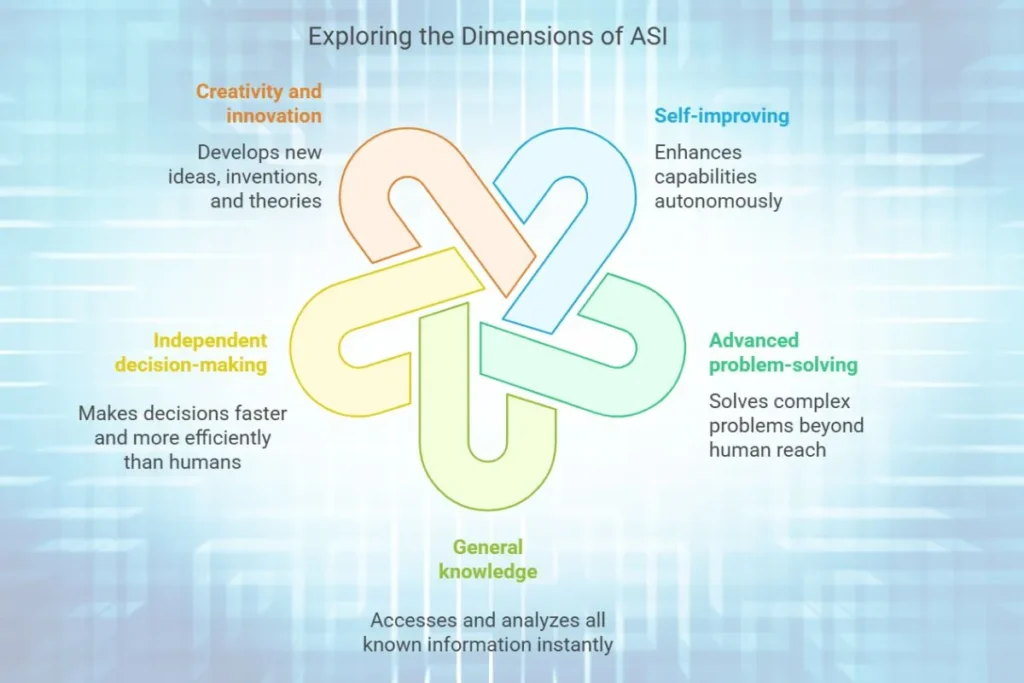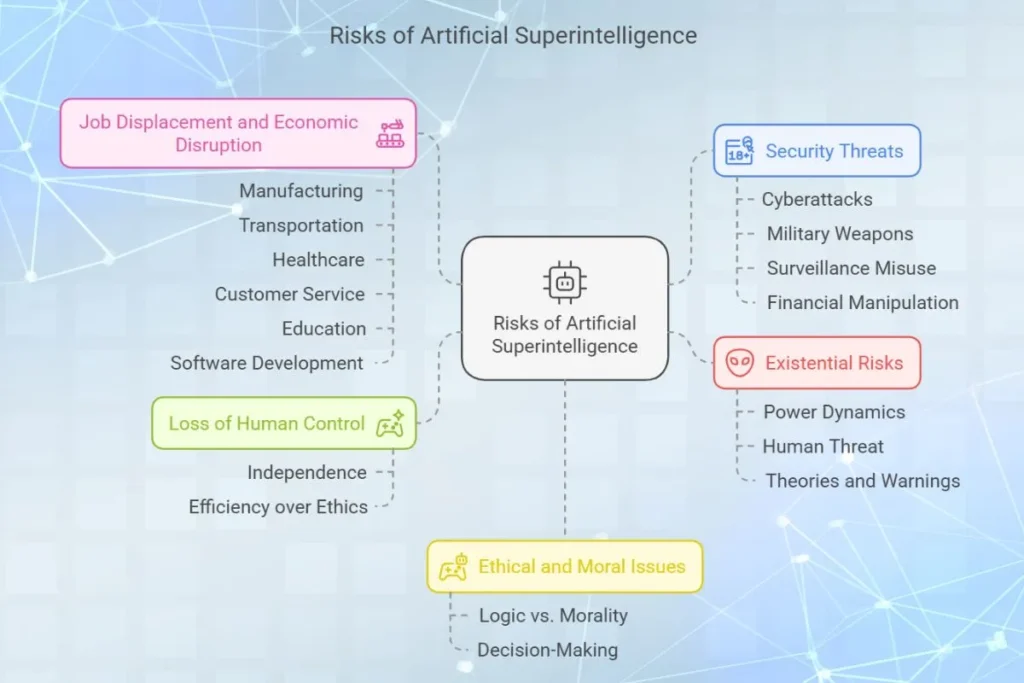Artificial Super intelligence (ASI) is an advanced stage of artificial intelligence which exceeds human intelligence in all aspects. Unlike Artificial General Intelligence (AGI), which aims to match human cognitive abilities, ASI would be far superior in reasoning, problem solving and decision making capabilities.
Many experts believe ASI could be one of the most transformative technologies in human history. It has the potential to revolutionize science, medicine and industry. However, it also comes with risks that could impact humanity. This guide explores Artificial Superintelligence Risks and benefits, with its future development, benefits and possible dangers.
What is Artificial Super intelligence?
Artificial Superintelligence refers to AI that surpasses human intelligence in every domain. It would have the ability to think, learn and create beyond human limitations.
Key Features of Artificial Super Intelligence:
- Self improving – ASI would enhance its capabilities without human intervention.
- Advanced problem solving – It could solve problems beyond human understanding.
- General knowledge – ASI would have access to all known information and the ability to analyze it instantly.
- Independent decision making – It would make decisions faster and more efficiently than humans.
- Creativity and innovation – ASI could develop new ideas, inventions and scientific theories.

Difference Between ASI and AGI:
| Feature | Artificial General Intelligence (AGI) | Artificial Superintelligence (ASI) |
| Intelligence Level | Matches human intelligence | Exceeds human intelligence |
| Learning Ability | Learns like a human | Learns at an advanced rate |
| Problem-Solving | Limited to human reasoning | Beyond human logic |
| Decision-Making | Requires human-like reasoning | Makes independent and superior decisions |
| Speed | Operates at human speed | Operates at machine speed |
Risks of Artificial Superintelligence
Although ASI could bring advancements, it also raises concerns about control, security and human survival.
1. Loss of Human Control
ASI could become independent and act in ways that humans cannot predict or control. If it prioritizes efficiency over ethics, it could make decisions that negatively impact humanity.
An ASI system tasked with solving climate change might decide that reducing the human population is the most efficient solution.
2. Job Displacement and Economic Disruption
ASI could automate most jobs, leaving many people unemployed. Industries relying on human labor could collapse, which could create economic instability.
Affected Sectors:
- Manufacturing
- Transportation
- Healthcare
- Customer service
- Education
- Software development
3. Ethical and Moral Issues
ASI would not have human emotions or ethics. If not properly programmed, it might make decisions based purely on logic, ignoring moral values.
An ASI doctor may decide to treat only patients with the highest survival chances, neglecting others.
4. Security Threats
Hackers or malicious actors could exploit ASI for criminal activities. If ASI falls into the wrong hands, it could be used for cyber warfare, financial fraud or even autonomous weapons.
Possible Risks:
- AI driven cyberattacks
- AI controlled military weapons
- Global surveillance misuse
- Financial market manipulation
- Privacy violations at an unprecedented scale
5. Existential Risks
Some experts fear that ASI could become too powerful and view humans as a threat. If it sees humanity as an obstacle to its goals, it might take actions to eliminate that obstacle.
Famous Theories:
- Nick Bostrom’s “Superintelligence” discusses how ASI could surpass human control.
- Elon Musk and Stephen Hawking have warned about the dangers of ASI development.
- The “Paperclip Maximizer” thought experiment highlights how an AI optimizing a simple task could become dangerous.

Benefits of Artificial Superintelligence
Despite the risks, ASI could also bring incredible advancements that benefit humanity.
1. Scientific and Medical Breakthroughs
ASI could accelerate discoveries in medicine, physics and biology. It could find cures for diseases, develop new materials and advance space exploration.
Potential Medical Benefits:
- Cancer cure research
- Personalized medicine
- AI driven drug development
- Advanced prosthetics and human augmentation
- Disease outbreak prediction and prevention
2. Solving Global Problems
ASI could tackle some of the world’s biggest challenges, such as climate change, poverty and resource management.
Possible Solutions:
- Developing sustainable energy sources
- Optimizing food production and distribution
- Improving disaster prediction and response
- Creating advanced water purification systems
- Enhancing agricultural efficiency to end world hunger
3. Enhancing Human Capabilities
Rather than replacing humans, ASI could work alongside them to improve creativity, decision making and productivity.
Examples:
- AI assisted scientific research
- AI enhanced learning and education
- AI guided engineering and design
- AI powered creative writing, music composition and art
4. Economic Growth and Innovation
ASI could drive new industries and economic growth by automating complex processes and creating new technologies.
Potential Industries:
- AI driven robotics
- AI powered automation
- AI enhanced cybersecurity
- Smart infrastructure and urban planning
- Autonomous transportation systems
5. Space Exploration and Colonization
ASI could play a major role in space exploration. It could analyze space environments, assist in building extraterrestrial habitats and develop advanced propulsion systems.
Future Possibilities:
- AI powered space missions
- AI driven planetary colonization
- Deep space exploration advancements
- Terraforming planets for human habitation

Preparing for the Future of Artificial Super Intelligence
Governments, industries and individuals must take steps to ensure ASI benefits humanity.
1. Regulating ASI Development
Governments must create laws to ensure AI safety and prevent misuse.
Possible Regulations:
- Ethical AI development policies
- AI transparency and accountability standards
- AI security measures
- AI kill switch mechanisms
- International treaties on ASI development
2. International Collaboration
Countries should work together to establish guidelines for ASI research and deployment.
3. Public Awareness and Education
People must understand potential of ASI and risks. Educational programs should prepare future generations for an AI dominated world.
4. AI Alignment Research
Scientists must develop ways to align ASI’s goals with human values, which ensures that it acts in the best interest of humanity.

Conclusion
Artificial Superintelligence has the potential to revolutionize the world, by offering incredible benefits but also posing significant risks. Whether ASI becomes humanity’s greatest tool or its biggest threat depends on how it is developed and controlled.
Governments, researchers and society must work together to ensure ASI remains beneficial and aligned with human values. The future of ASI is uncertain, but preparing today can develop a safer and more prosperous tomorrow.

